This week’s UKHSA vaccine surveillance report has landed – and this week a change. In the (in)famous Table 12, which shows rates of infections, deaths and hospitalisations per 100,000 by vaccination status, the data have suddenly switched to giving rates for triple-jabbed rather than two-or-more doses, meaning we no longer have continuity with our previous data. So sudden was the change in fact, that the report itself has not kept up with it, and the notes under the table still say the rates are for “people who have received either two doses of a COVID-19 vaccine or in people who have not received a COVID-19 vaccine”.
The change means we have to start over in our week-by-week comparisons, so the infection rates by age for this period are depicted above and the unadjusted vaccine effectiveness figures are depicted below.
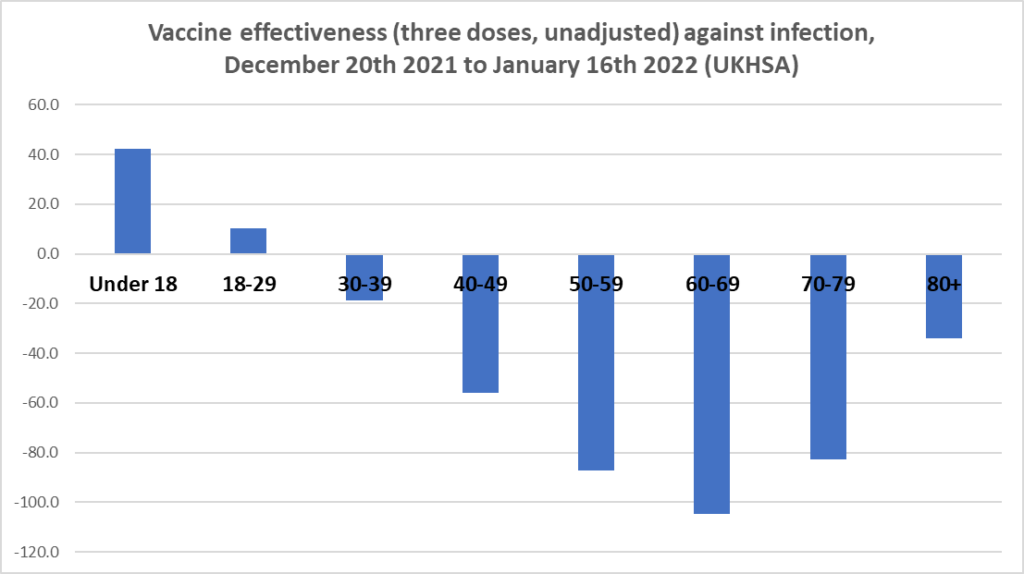
Below is how the total reported infections for the period break down by vaccination status (in this chart vaccinated means one or more doses). While the chart doesn’t take into account the different numbers of people vaccinated and unvaccinated, with over 70% of infections in the vaccinated it does show that the outbreak is predominantly in vaccinated people.
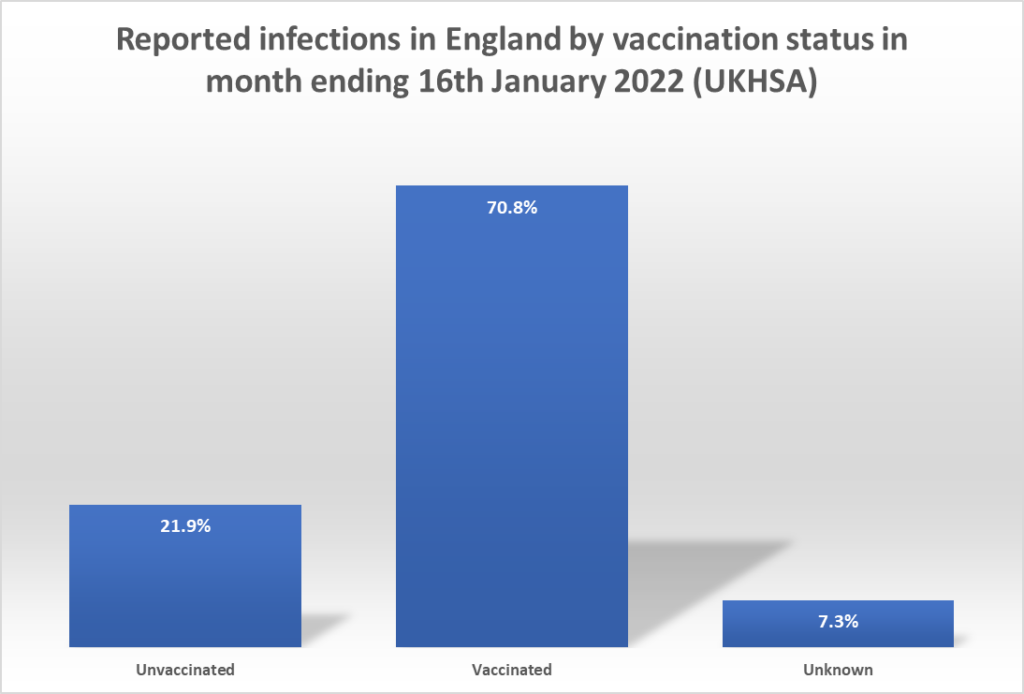
Below is what our previous chart would look like if we just added the new data in, but the trend in the past week is obviously nonsense as they’ve changed the parameters. Still, it gives an indication of the difference between the double and triple jabbed, and note that all but the under-30s are still negative (meaning higher infection rates in the vaccinated than unvaccinated), and the under-30s are still low. Also, the over-70s declined since last week anyway, despite the switch to triple-jabbed only. Makes you wonder what the data for two-or-more doses would have shown.
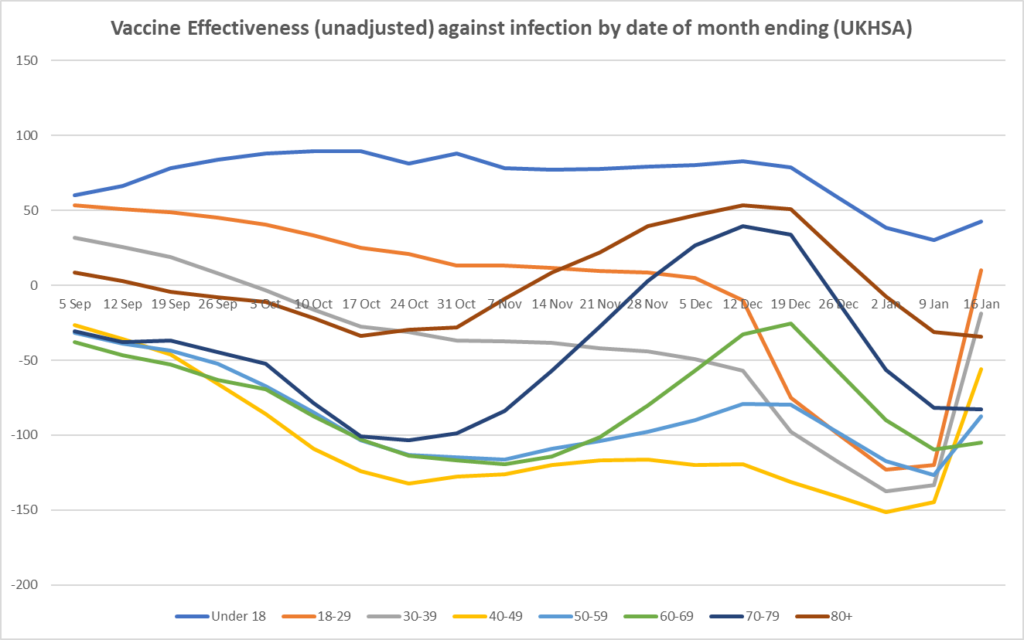
The negative effectiveness in the raw data here is being seen elsewhere, including in Scotland, Ontario and Iceland, and the UKHSA should be investigating this striking phenomenon properly by quantifying the potential confounders and producing adjusted estimates from the data.
Instead, the agency continues to insist, ludicrously, that “comparing case rates among vaccinated and unvaccinated populations should not be used to estimate vaccine effectiveness against COVID-19 infection”. (A new ‘fact check‘ from Full Fatuous has even appeared to hammer home the point again.) But that is an untenable position – of course vaccine effectiveness can be estimated by “comparing case rates among vaccinated and unvaccinated populations” – and as I noted in a post earlier, this is shown once more by the U.S. CDC, which has just published a report estimating hazard rates (an equivalent quantity to vaccine effectiveness) by doing just that. Furthermore, while the CDC study controlled for prior infection and adjusted for age, it deemed biases from other potential confounders to be “minimal”. This shows up the UKHSA’s excuses for what they are, and they should no longer be accepted.
For completeness, here are the charts for hospitalisations and deaths, though again the sharp rise this week is an artefact owing to switching to triple-jabbed only. The UKHSA report’s official estimate of vaccine effectiveness for the double-dosed against hospitalisation from Omicron after six months is 30-55%.
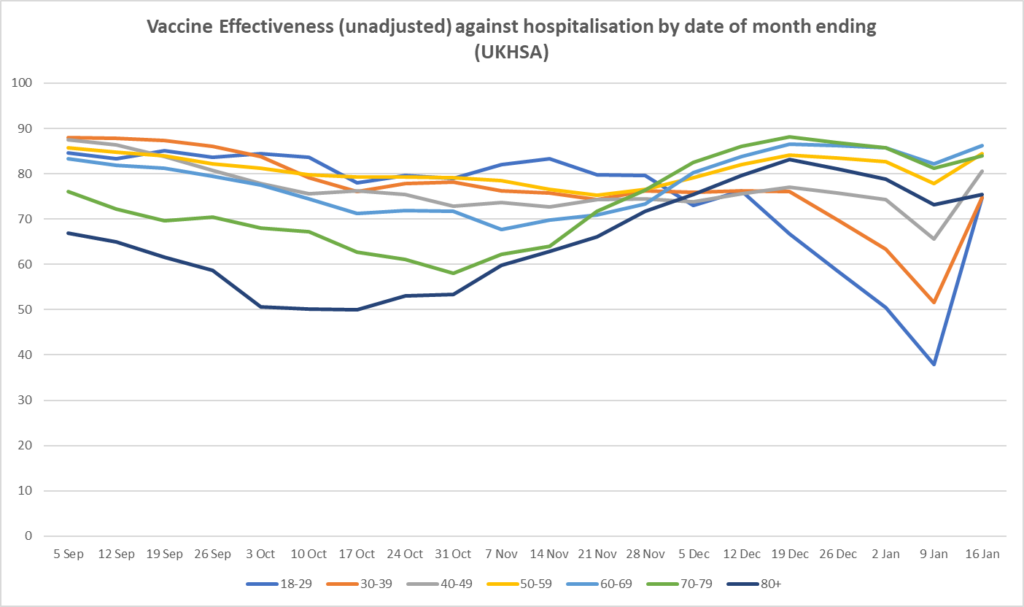
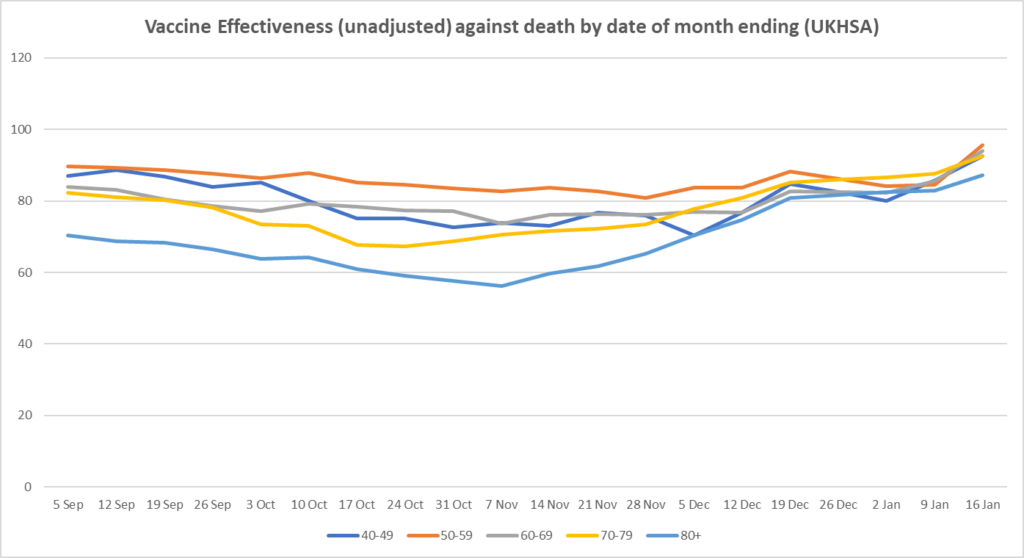

Stop Press: Eugyppius draws on the data from last week’s report to estimate the missing data from this week’s, and comes to a disturbing conclusion: that the two-dose-only group have much higher Covid death rates than the unvaccinated. This is disturbing as the report states that the high risk are prioritised for boosters, meaning the death rate in the remaining two-dose-only population should be biased low, not high.
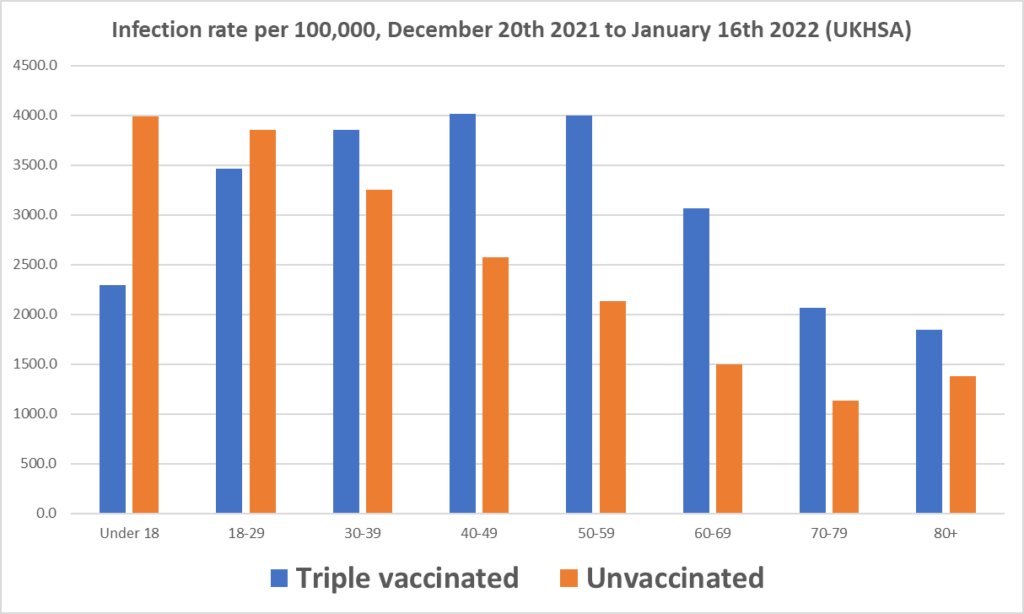












To join in with the discussion please make a donation to The Daily Sceptic.
Profanity and abuse will be removed and may lead to a permanent ban.
These disgusting, tasteless and highly unethical adverts ( seriously, who TF thought a woman jumping for joy would be a good way to portray this incredibly complicated, emotive and serious subject? It’s not a Tena Lady commercial. ) for assisted dying on the Tube are owned by Global and Sadiq Khant is a partner, so it’s doubtful he’ll take them down, but perhaps given sufficient pushback from the public he may be forced to. Charlotte Gill has been playing detective very effectively once again;
https://x.com/CharlotteCGill/status/1861189774628831434
More detailed, longer video here as Charlotte explains her very interesting findings;
https://x.com/CharlotteCGill/status/1861064648222527822
Fair play to whoever did this. I am pro-choice when it comes to euthanasia but I find selling this idea as some sort of appealing option for certain individuals who are on the brink with their mental health or feel it’s the only way out if they think they’re a burden is crossing a serious line. This should be outright illegal;
https://x.com/fleurmeston/status/1861130257606054213
”The links I’ve found are between:
Alastair Campbell
Tony Blair
Sadiq Khan
Global
Carol Vorderman, James O’Brien, The News Agents (publicity wings)
Led by Donkeys, Greenpeace, WWF
UN, US Embassy in London
Parliament (a group of MPs. More soon).” Charlotte Gill
It’s amazing how one name keeps popping up when discussing the daily attacks on this country…
Tony firkin Bliar.
Every advert on every outlet is mostly devoid of white people or mish mashed with all ethnic groups but this one is solidly white ! Khants racism on full view ! Disgusting Ad btw , (whoever would have been in it ) .
I did not know this about those dreadful bird-killing, planet unfriendly eyesores;
”Did you know that wind turbine blades shed?
Motvind UK is extremely concerned at the quantities of debris shed from wind turbine blades due to leading edge erosion and stress cracking.
Based on specific repair epoxy usage alone, this equates to 15 to 23 kg per turbine per annum (PA) depending on the size of the blade.
This correlates to the average weight of repair epoxy required currently IRO 10 to 15 kg per turbine PA with the fleet of 11,000 UK turbines that are predominantly smaller than the upwards of 27 tonne blades being installed today.
What does this debris comprise of?
Glassfibre dust and shards containing PFOA in the form of Bisphenol A
Coatings containing PFAS
What are the likely outcomes for our health, animals, food and water?
Health and Safety professionals are describing PFAS as ‘this generation’s asbestos’.
Nobody is making the connection with wind turbines, yet the quantities involved are staggering and these emissions are not even considered in the Environmental Statements for new wind farms.
The attached photo is from within the industry, which is well aware of the problem, but only in as much as it reduces efficiency, increases service costs, and affects profits.”
https://x.com/lawrie_dr/status/1861089099471331728
Thanks. I didn’t know about this either.
Quick To Jab So Many Dead – latest leaflet to print at home and deliver to neighbours or forward to politicians, your new MP, your local vicar, online media and friends online. Start a local campaign. We have over 200 leaflet ideas on the link on the leaflet.
Jaguar’s rebrand is the latest attempt to subvert history and tradition
There is an alternative Jaguar rebrand in progress…
https://www.youtube.com/watch?v=5C8cSrU_CV0
https://x.com/chrismartzwx/status/1860901676053373346
watched this TikTok video about fossil fuels to the end and left asking why the young woman ends up in a bikini? What the hell is that about?
Yes, I thought that a little odd.
Rare golden eagle killed after flying into wind turbine in Galloway
The latest feeble attempts at justification:
Doublespeak
‘Golden eagle mortality from wind turbine collisions in Scotland is, thankfully, a rare occurrence. That’s not down to luck, or chance. It’s largely to do with detailed wind farm planning and choosing areas for turbines that are not located in habitats preferred by golden eagles.’
Written by a colleague of the professional weirdo, Packham
Translation
Golden Eagles are rare in Scotland now since much habitat is closed off to them by the egregious spread of wind farms.
Doublespeak
‘Other sources of electricity are also more lethal for birds than wind energy. A 2012 study found that wind projects kill 0.269 birds per gigawatt-hour of electricity produced, compared to 5.18 birds killed per gigawatt-hour of electricity from fossil fuel projects.6 That’s in part due to collisions with equipment (wind turbines aren’t the only energy infrastructure birds can fly into), but mostly because of the environmental impact of fossil fuels. Climate change is really dangerous for birds.’
Translation
‘We estimated the figures. We don’t want to distinguish between birds in general and rare migrating species, raptors so, obfuscating, obviously based on an estimate plucked out of thin air, nuclear power, fossil fuels, windows and cats are the main threat to birds in general.’
For reference:
‘Birds are particularly vulnerable for three reasons. Firstly, seabirds are negatively impacted through the loss and modification of resting and foraging grounds. Secondly and most importantly, they are killed as a result of collisions with turbine blades: for example, significant fatalities have been reported at marine wind farms situated close to breeding colonies (Everaert and Stienen 2007). Also, during their seasonal migrations, huge numbers of passerines cross Europe’s seas mostly at night and at a low altitude. It is inevitable that birds will collide with turbines, particularly under adverse weather conditions with poor visibility (Hüppop et al. 2006). Thirdly, several studies have found that offshore wind farms act as barriers to travelling seabirds. Displacement from their favoured routes is likely to increase travel distances, causing greater energy expenditure and potentially impacting the survival of nestlings by lowering provisioning rates (Petersen et al. 2003, Fox et al. 2006). For example, at the Nysted offshore wind farm in Denmark, travelling birds (particularly seaduck) displayed profound avoidance behaviour, with the number of birds entering the area declining dramatically following the construction of the wind farm (Desholm and Kahlert 2005).’
Birdlife International
‘Species richness, abundance, and unique species of birds were relatively higher in control sites over wind turbine sites…….The study indicates that certain bird and mammal species avoided wind turbine-dominated sites, affecting their distribution pattern. This is of concern to the management of the forested areas with wind turbines.’
https://www.nature.com/articles/s41598-022-05159-1
And so and so forth. A two minute trawl…….
They’re not called bird-choppers for nothing.
Yes, I read a few years back that the true number of bird fatalities in the USA is hidden by the wind turbine companies’ devious way of collecting the data.
Since they know that the dead and dying birds are usually flung hundreds of yards away from the turbine blades (I don’t remember the exact figure), they simply select a much smaller radius in which to survey and record the dead birds and bats.
“Assisted dying is sexist, report finds”
I await the news of whether it is also racist. My breath is baited…
No, it’s death as a whole that’s racist.
But it actually IS racist, because the only ones signing up to be Medically Murdered are Ethnic Europeans.
You don’t get Third World Ethnics going off to those EU Death Clinics, nor do they commit suicide in other ways very often. It’s mostly the white folks committing suicide in the West. It’s also mostly the White Children getting the mysterious and previously unknown “Childhood Cancers” and other horrible fatal diseases with fancy names for Vaccine Genocide.
As someone said,
“I stand with the White Folks, because no one else will.”
The West is at war with three formidable enemies… and only one politician can save us
And, particularly, the West is at war with the authoritarian, totalitarian dictatorship in Russia. In fact Putin is at war with us.
How shall President Trump save us (Oh lord)?
https://www.youtube.com/watch?v=hloWmE_3d2I
‘In August, talks began between Washington and Kyiv to formalise economic cooperation, launch joint investment projects, and devise plans to seize frozen Russian assets to support Ukraine’s reconstruction efforts.
Ukrainians want and need American businesses to help turn its mining and processing industries into world-beating sectors and to produce high-tech products and semiconductors.
The European Union and its companies will also invest in Ukraine
Kyiv’s other offer to President Trump is that Ukrainian soldiers replace American ones posted at NATO bases across Europe. This would save the US billions, and their cost would be borne by European nations, which have benefited more than any other region from Ukraine’s sacrifices.
The “Victory Plan” will develop Ukraine’s vast resource wealth, rebuild the country, pay back its allies, and serve as a security guarantee.
European troops inside Ukraine will secure any Trump peace deal.
And Brussels is in the process of redirecting billions of euros to defense and security.
That, along with substantial Western investments in the country for reconstruction and creating an extensive resource sector and military-industrial complex, will be as valuable as membership in NATO.’
Diane Francis
The only question is:
Where will Britain’s even more worst government find the money/resolve to fund the British Army Corps that the Ukrainians want to participate in the ceasefire settlement?
Putin is at war with us or we are at war with Putin?
All foreign troops should be removed from Europe: they are not necessary and USA placing ever more nuclear missiles in Europe aimed at Russia is asking for trouble, which can only result in war and destruction here in Europe.
I have no desire to see Ukrainian soldiers in Europe any more than US soldiers. Europe is at peace and will stay that way if our politicians promote diplomacy rather than US belligerency.
Each European country should, however, have sufficient military strength of its own to protect its borders and its citizens.
Britain, spending less than 2.3% of its GDP on defence, has seldom been less prepared for war……but, together with the U.S., the strategy of weakening Russia in response to its serial invasions of its neighbours, so that it can no longer invade, has been an astonishing success. Newly trained and equipped Ukrainian forces are, even now, poised for a new offensive.
But who, really was the aggressor? A dumb question:
After its 2014 invasion of Ukraine, Russia had been planning the 2022 invasion for several years, waiting for an auspicious moment to strike, while simultaneously carrying out a massive disinformation campaign, denying and concealing preparations for the invasion. Biden’s chaotic withdrawal from Afghanistan indicated weakness. Like Saddam Hussein before him, Putin confused incompetence with weakness.
The North Atlantic Treaty Organization (NATO) was pictured as a villain in Putin’s tales. The Russian leader routinely blamed NATO for his decision to attack Ukraine. He repeatedly claimed that despite the promise given to Russia in 1990, NATO expanded to the East and “reached Ukraine.” There was no such promise. Since its establishment in 1949, NATO has never changed its “open door policy.” The United States, Europe and Russia have never signed any treaty or agreement containing provisions limiting NATO membership for Eastern European countries.
Kremlin’s spokesman Dmitry Peskov falsely claimed that “Russian military infrastructure has never moved toward Western Europe, there has always been a movement in the opposite direction. In fact, since Putin came to power in 2000, Russia has built dozens of new military bases and reinvigorated Soviet military installations along its borders with Western Europe. In 2014, Russia seized and began using several Ukrainian military bases in occupied Crimea and Donbas.
Russia used the war against Ukraine to push Moscow’s military power westward. In 2023, Russia began stationing tactical nuclear weapons in Belarus, which borders three NATO countries — Poland, Lithuania, and Latvia.
But, despite the weakness of its European enemy and its own aggressive intent, Russia, pursuing the same course as the Tsars, Lenin and Stalin, has, as with them, paid a heavy price for Putin’s delusions of empire…….
And it’s going to get worse, in all likelihood much worse……..
… together with the U.S., the strategy of weakening Russia in response to its serial invasions of its neighbours, so that it can no longer invade, has been an astonishing success …
If Russia has a problem with its neighbours then that is a matter which Russia and its neighbours need to settle: there is no reason for US, UK, EU or NATO interference.
Israel apparently has a problem with its neighbours and I do not hear you or anyone else screaming and shouting that all those aforementioned countries should intervene (sadly).
After its 2014 invasion of Ukraine, Russia had been planning the 2022 invasion for several years, waiting for an auspicious moment to strike, while simultaneously carrying out a massive disinformation campaign, denying and concealing preparations for the invasion.
You mean after the Russian takeover of Crimea, followed by universal acceptance by its inhabitants of the Russian action. Now just why were the Crimeans so unhappy under the Ukrainian government?
President Putin is not stupid and he will have subsequently noticed the videos of Zelensky smirking while he, Putin, was talking and signing the Minsk Peace Agreements. Merkel and Hollande both recently admitted that the peace agreements were solely in place to allow more time for western military training and a build-up of western weapons in Ukraine, i.e. it was the western and Ukrainian leaders that lied and deceived Putin. That Russia presumably decided they should pre-emptively build up their military forces was clearly both sensible and justified.
… despite the promise given to Russia in 1990, NATO expanded to the East and “reached Ukraine.” There was no such promise.
You know very well there were indeed many documented promises that NATO would not “move one inch” to the east because I published the reference some time ago. In case your memory has failed you, here is the link again: https://nsarchive.gwu.edu/briefing-book/russia-programs/2017-12-12/nato-expansion-what-gorbachev-heard-western-leaders-early?utm_source=substack&utm_medium=email.
Russia has built dozens of new military bases … and began using several Ukrainian military bases in occupied Crimea and Donbas.
Wikipedia only lists 21 Russian bases abroad, not exactly dozens, and conquered territory is, well, conquered territory. And how many hundreds of bases does USA maintain abroad? They just opened yet another one in Spain. Would it surprise you if Russia opened another base or two now that Finland has joined NATO?
Could we have less propaganda and more facts, please? Actually, feel free to stop your daily propaganda sheets.
My mistake: the new US base is in Poland, not Spain.
Is Britain prepared for war?
British Army deployable strength 10,000
Russian Army deployed strength 600,000
With those numbers, just how dumb do you have to be to be constantly ‘poking the bear’?
Over the weekend, the Russian forces lost approximately 195 tactical vehicles and fuel trucks, 129 unmanned aerial systems, 70 artillery pieces and multiple launch rocket systems, 68 infantry fighting vehicles and armored personnel carriers, 16 main battle tanks, 7 pieces of special equipment, and 2 air defense systems.
Overall, the Russian forces have lost almost 700,000 troops and tens of thousands of heavy weapon systems in 978 days of fighting.
By the current rate, the Kremlin will have suffered nearly 750,000 losses before the year is out.
The U.S. could never have expected a level of battlefield incompetence of this magnitude.
And Ukraine is organising for a further offensive…..
Your loss values are hardly credible. Sorry if I am too lazy to count up the Russian MoD figures of Ukrainian losses over the weekend. Why are Ukrainian officers complaining that their new recruits are aged 50+ and provided with medical certificates from their doctors saying they should not be forced to fight?
Still, despite the massive attrition, Russian morale seems solid……or not really…..
‘Shortly after the full-scale war began, Anton said he was given what he describes as a “criminal order” – to hold lectures with his troops using very specific written guidelines.
“They said that Ukrainian civilians are combatants and should be destroyed!” he exclaims. “That’s a red line for me – it’s a war crime. I said I won’t spread this propaganda.”
Senior officers reprimanded Anton by transferring him to a regular assault brigade in another part of the country. He was told he would be sent to war.
These units are often sent in to battle as the “first wave” and a number of Russian deserters have told the BBC that “troublemakers” who object to the war have been used as “cannon fodder”.
The Russian embassy in London did not respond to a request for comment.
Before he could be sent to the front line, Anton signed a statement refusing to take part in the war and a criminal case was opened against him. He showed us documents confirming his transfer to the assault brigade and details of the criminal case.
He then decided to flee the country with the help of a volunteer organisation for deserters’
No wonder they are deserting in droves:
https://x.com/wartranslated/status/1861471529130742019?ref_src=twsrc%5Egoogle%7Ctwcamp%5Eserp%7Ctwgr%5Etweet
“Israel gives green light to Hezbollah ceasefire deal in Lebanon”
Isn’t it funny how, when forced to the brink of eradication, you decide you want a ceasefire!
Having seen this happening in Lebanon maybe Hamas will start requesting a ceasefire too?
I wonder if Isreal will allow one? or fight on until they’re all dead?
Watch this space
“Rare golden eagle killed after flying into wind turbine in Galloway”
Ha ho, that’s the price we have to pay for Milibrains net zero!
No price is too expensive apparently wether it be whales, dolphins, birds,bats,farm land, human slavery, vast amounts of of tax payer cash, environmental destruction through mass mining, and all the other ‘bonuses’ to the environment the world will enjoy
“BBC will not replace Gary Lineker on Sports Personality as all-female presenting line-up announced”
I darned well hope they are all black gay women or I’ll be the first to complain!
Maybe Gary Lineker will self-identify as a woman and be re-hired.
I find it hard to believe people still watch this tosh
Aunty Beeb has an article on the web ‘I want to get a job but I don’t know how‘
It details the plight of a young Birmingham resident who left school in 2022 and has not worked since.
When I was at school (a long time ago) the answers to all these questions and more used to be covered in specially constructed lessons after the exams had finished. Sure we could piss about (and some did) but we covered responding to job adverts, interview technique (don’t be cocky and don’t lie) and writing a CV (for school kids that meant qualifications followed by any volunteering and then interests). We also covered basic property rental rules, regs and responsibility (especially for those about to leave home for uni for the first time) and different types of mortgages and how they work.
I’m sure the advice and circumstances have changed since then but clearly this poor so-and-so didn’t get any of that.
But even without all that, how difficult is it to google ‘how to apply for a job’? More information at our fingertips than ever before in history, but clearly lacking the wherewithal to use it
It is with great sadness that we announce the loss of a number of businesses as a result of Rachel Reeves’ recent budget announcement.
A local bra manufacturer has gone bust, a submarine company has gone under, a manufacturer of food blenders has gone into liquidation, a dog kennel outlet has had to call in the retrievers, and a company supplying paper to origami enthusiasts has folded.
The local horologist has also called time, the strip club has gone tits up, Interflora is pruning its business and Dyno-rod has gone down the drain.
The saddest loss is the ice cream van man found dead, covered in nuts and raspberry sauce. He couldn’t take it any more and topped himself.
Great peice of humour..takes the edge off this bloody mad world!
“Asylum hotels could bring Britain’s welfare state to its knees”
After reading an excellent, brief summary of WHITE SLAVERY yesterday, one part describing how the Muslim Tatars would send out armies of 10,000 men to “Harvest” every living human in huge areas of Ukraine and southern Russia, dragging away 25,000 Christians in one fell swoop, as well as their livestock, I suddenly realised that that is what the Globalists are planning for the West.
Only this time it will be ridiculously easy, since the Muslim Armies are already dug in here at our expense, relaxing while awaiting the signal.
Please take a few minutes to look at this brief summary, recommended by a DS commenter whose name I can’t remember:
Setting the Record Straight: White Europeans Were Captured and Traded as Slaves for Centuries | Winter Watch
“Children told refugees ‘enrich our country’ and drive ‘growth’ in Usborne book”
Instead, teenagers should be taught this:
Setting the Record Straight: White Europeans Were Captured and Traded as Slaves for Centuries | Winter Watch
Excellent link, very good and well sourced article
Totally agree, all sides of the slave trade should be taught including the continuing modern day trade!
Oh well done for taking time to read that article— I thought it was a superb summary. I’m only sorry that I can’t remember who first linked it on here yesterday, I think, but since it was kind of buried in a small reply somewhere, and was pertinent to the News Round-Up today, I wanted to draw it to people’s attention.
You are absolutely right to mention the modern day slave trade, too, because it is all still going on, hidden away in the darkness.
I remember only a few years ago, reading an article by an investigative journalist on modern day White Slavery, especially the kidnapping of blond Slavic people secretly enslaved in Muslim countries. He actually interviewed a young Russian man who had been kidnapped, castrated and forced to work as a eunuch in a Muslim harem for years, giving baths to all the women, waiting on them hand & foot, and serving as their slave. He was in despair at ever being able to return home to Russia, because he thought he would be reviled as a freak and an outcast, but I’m sure he was wrong. His Russian people would have welcomed him home, and helped him recover from the long trauma of enslavement.